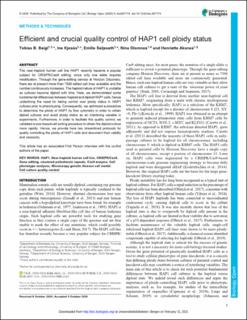| dc.contributor.author | Beigl, Tobias B. | |
| dc.contributor.author | Kjosås, Ine | |
| dc.contributor.author | Seljeseth, Emilie | |
| dc.contributor.author | Glomnes, Nina | |
| dc.contributor.author | Aksnes, Henriette | |
| dc.date.accessioned | 2021-07-07T11:36:36Z | |
| dc.date.available | 2021-07-07T11:36:36Z | |
| dc.date.created | 2021-02-15T11:14:40Z | |
| dc.date.issued | 2020 | |
| dc.identifier.issn | 2046-6390 | |
| dc.identifier.uri | https://hdl.handle.net/11250/2763778 | |
| dc.description.abstract | The near-haploid human cell line HAP1 recently became a popular subject for CRISPR/Cas9 editing, since only one allele requires modification. Through the gene-editing service at Horizon Discovery, there are at present more than 7500 edited cell lines available and the number continuously increases. The haploid nature of HAP1 is unstable as cultures become diploid with time. Here, we demonstrated some fundamental differences between haploid and diploid HAP1 cells, hence underlining the need for taking control over ploidy status in HAP1 cultures prior to phenotyping. Consequently, we optimized a procedure to determine the ploidy of HAP1 by flow cytometry in order to obtain diploid cultures and avoid ploidy status as an interfering variable in experiments. Furthermore, in order to facilitate this quality control, we validated a size-based cell sorting procedure to obtain the diploid culture more rapidly. Hence, we provide here two streamlined protocols for quality controlling the ploidy of HAP1 cells and document their validity and necessity. | en_US |
| dc.language.iso | eng | en_US |
| dc.publisher | The Company of Biologists | en_US |
| dc.rights | Navngivelse 4.0 Internasjonal | * |
| dc.rights.uri | http://creativecommons.org/licenses/by/4.0/deed.no | * |
| dc.title | Efficient and crucial quality control of HAP1 cell ploidy status | en_US |
| dc.type | Journal article | en_US |
| dc.type | Peer reviewed | en_US |
| dc.description.version | publishedVersion | en_US |
| dc.rights.holder | Copyright 2020. Published by The Company of Biologists Ltd. | en_US |
| dc.source.articlenumber | bio057174 | en_US |
| cristin.ispublished | true | |
| cristin.fulltext | original | |
| cristin.qualitycode | 1 | |
| dc.identifier.doi | 10.1242/bio.057174 | |
| dc.identifier.cristin | 1889780 | |
| dc.source.journal | Biology Open | en_US |
| dc.relation.project | Norges forskningsråd: 249843 | en_US |
| dc.identifier.citation | Biology Open. 2020, 9 (11), bio057174. | en_US |
| dc.source.volume | 9 | en_US |
| dc.source.issue | 11 | en_US |

